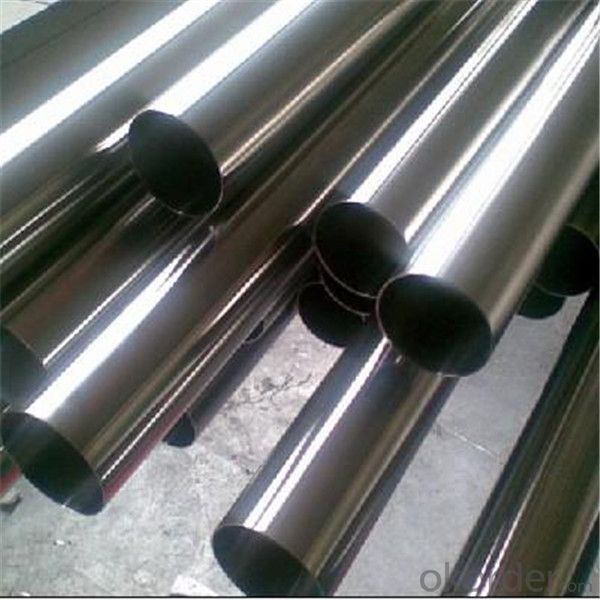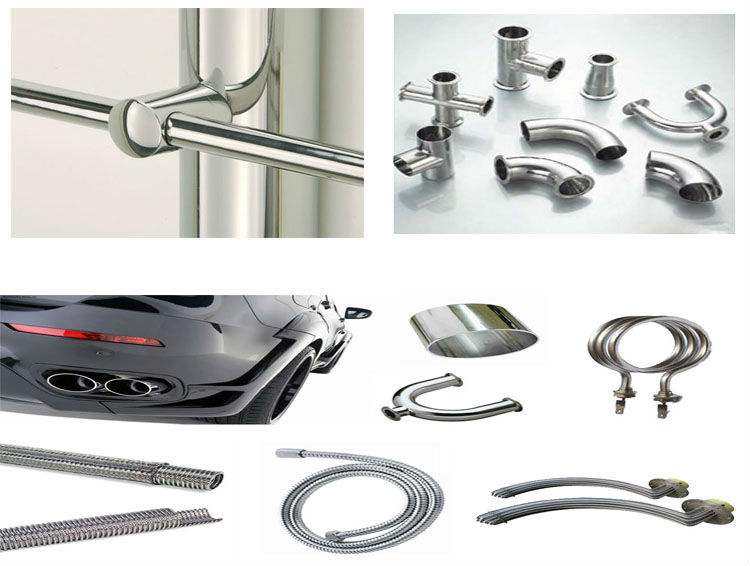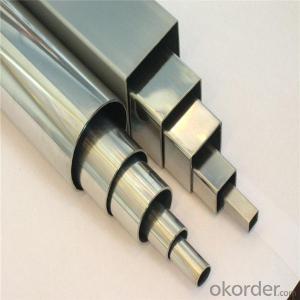304 304l 316 316l 317 317l Stainless Steel Welded Pipe
- Loading Port:
- Shanghai
- Payment Terms:
- TT OR LC
- Min Order Qty:
- 2 m.t.
- Supply Capability:
- 25000 m.t./month
OKorder Service Pledge
OKorder Financial Service
You Might Also Like
Item specifice
304 304l 316 316l 317 317l stainless steel welded pipe
1. Product Description
The details of my company | |||
The stainless steel sheet/coil/strip | |||
standard | ASTM,GB | ||
material | 201,202,301,304,316,316L,316LN,317,317L,309,309S,310,310S,430,409 | ||
specification | thickness | 0.3mm—20mm | |
width | 120mm—2000mm | ||
Production technology | Hot rolled , | ||
cold rolled | |||
Surface treatment | 2B,BA,8K,No.1,Etching,Hairline,Satin,Mirror,Vibration,Bead Blast,Embossed | ||
The stainless steel pipe | |||
standard | ASTM,GB | ||
material | 201,202,301,304,316,316L,316LN,317,317L,309,309S,310,310S,430,409 | ||
specification | Wall thickness | 0.3mm-60mm | |
Round | 6mm-630mm | ||
Square | 10*10mm-150*150mm | ||
rectangle | 10*20mm-100*200mm | ||
Surface treatment | Polishing (180#,220#,240#,320#400#,600#), Hairline,aid pickling and so on | ||
Production technology | Seamless steel pipe | ||
Welded steel pipe | |||
Surface treatment | Polishing or not | ||
The stainless steel bar | |||
standard | ASTM,GB | ||
material | 201,202,301,304,316,316L,316LN,317,317L,309,309S,310,310S,430,409 | ||
specification | Round | ||
Square | |||
rectangle | |||
Product Show
2. Product Pictures of 304 304l 316 316l 317 317l stainless steel welded pipe


3. Applications
Milk and food industry, pharmaceutical industry, industries with special internal surface requirements.

4. Stainless steel conservation
Stainless steel is a popular metal for appliances these days. Many kitchen appliances, both large and small, are made with stainless steel. Pots and pans and eating utensils are also made with stainless steel. One advantage of stainless steel is that is very resistant to rusting. But it can get rust stains from transference of rusty objects. You can keep stainless steel rust-free by following a few simple steps.
Clean frequently with a cleaner and water. Any cleaner that is safe for glass is usually safe for stainless steel.
Scrub off all rust from these objects with a scrubbing pad or steel wood pad. This means getting rid of rust from pots and pans before putting them into a stainless steel sink or on top of a stainless steel stove.
Put a rubber mat at the bottom of the stainless steel sink before placing rusted pots and pans (such as cast iron cookware) in the sink.
Apply a thin layer of lubricant (such as mineral oil) to the surface of the stainless steel. This prevents rust from forming.
Inspect equipment frequently, if you notice discoloration, tarnish or water stains, increase the frequency of your fresh water rinses to reduce accumulated chemicals
- Q:Are stainless steel pipes resistant to corrosion?
- Yes, stainless steel pipes are highly resistant to corrosion. This is due to the presence of chromium in stainless steel, which forms a passive layer on the surface of the pipe. This passive layer acts as a protective barrier, preventing the metal underneath from coming into contact with corrosive substances. The chromium content in stainless steel is typically at least 10.5%, which is higher than other types of steel, and this helps to enhance its corrosion resistance. Stainless steel pipes are widely used in various industries such as construction, oil and gas, and automotive, where corrosion resistance is essential to ensure the longevity and integrity of the pipes.
- Q:Can stainless steel pipes be coated?
- Yes, stainless steel pipes can be coated. Coating stainless steel pipes serves several purposes, such as enhancing their durability, preventing corrosion, providing insulation, and improving their aesthetics. There are various types of coatings available for stainless steel pipes, including epoxy coatings, polyurethane coatings, and fusion-bonded epoxy coatings. These coatings are applied to the surface of the stainless steel pipes through different methods, such as spraying, dipping, or electrophoretic deposition. The choice of coating depends on the specific requirements of the application and the environment in which the pipes will be used. Coating stainless steel pipes can significantly extend their lifespan and enhance their performance, making them suitable for various industries such as oil and gas, chemical, water treatment, and construction.
- Q:What is the difference between 17-7 and 15-7 stainless steel pipes?
- The main difference between 17-7 and 15-7 stainless steel pipes lies in their composition and properties. The numbers 17-7 and 15-7 refer to the specific ratios of alloys present in the stainless steel. 17-7 stainless steel contains approximately 17% chromium and 7% nickel, along with small amounts of other elements. This composition gives it high strength, excellent formability, and good corrosion resistance. It is often used in applications that require high strength and resistance to fatigue, such as aerospace components and springs. On the other hand, 15-7 stainless steel contains approximately 15% chromium and 7% nickel, with the addition of 2% molybdenum. This addition of molybdenum enhances the material's corrosion resistance, making it suitable for applications in harsh environments and chemical processing industries. In summary, while both 17-7 and 15-7 stainless steel pipes offer good corrosion resistance and are capable of withstanding high strength requirements, 15-7 stainless steel pipes provide enhanced corrosion resistance due to the addition of molybdenum.
- Q:What are the different grades of stainless steel used in pipes?
- There are several different grades of stainless steel used in pipes, including 304, 316, 321, and 409. These grades vary in their chemical composition and properties, making them suitable for different applications and environments.
- Q:How do you calculate the expansion and contraction of stainless steel pipes?
- To calculate the expansion and contraction of stainless steel pipes, you need to consider the coefficient of thermal expansion for the specific grade of stainless steel being used. The coefficient of thermal expansion is a measure of how much a material expands or contracts in response to changes in temperature. First, determine the initial length of the stainless steel pipe, which is usually measured at room temperature. Then, determine the change in temperature that the pipe will be exposed to. The change in temperature is the difference between the maximum and minimum temperatures the pipe will experience. Next, multiply the initial length of the pipe by the coefficient of thermal expansion for the specific grade of stainless steel being used. The coefficient of thermal expansion for stainless steel can vary depending on the alloy and its composition, so it is important to consult the manufacturer's specifications or engineering references for the specific grade being used. Finally, multiply the result by the change in temperature to calculate the expansion or contraction of the stainless steel pipe. A positive value indicates expansion, while a negative value indicates contraction. It is important to note that the calculated expansion or contraction of the stainless steel pipe is an approximate value and can vary depending on various factors such as the specific alloy composition, manufacturing processes, and installation conditions. Therefore, it is recommended to consult with a qualified engineer or refer to industry standards for more accurate calculations in specific applications.
- Q:How do stainless steel pipes perform in extreme weather conditions?
- Stainless steel pipes are known for their excellent performance and durability in extreme weather conditions. Due to their unique composition, stainless steel pipes have a high resistance to corrosion, making them ideal for use in various environments, including extreme weather conditions. In extremely cold weather, stainless steel pipes retain their strength and flexibility, unlike other materials that may become brittle or crack. This makes them suitable for applications such as oil and gas pipelines, where they can withstand low temperatures without compromising their performance. Similarly, in extremely hot weather, stainless steel pipes exhibit excellent heat resistance, preventing them from warping or deforming. This quality is crucial in industries like power generation, where high-temperature environments are common. Furthermore, stainless steel pipes have a high melting point, enabling them to maintain their structural integrity even in the presence of intense heat. This makes them resistant to fire damage, making them a safe choice for applications that require fire protection. Stainless steel pipes also have exceptional resistance to UV radiation, which can be damaging over time. This property ensures that the pipes do not degrade or weaken when exposed to direct sunlight or extreme weather conditions, making them suitable for outdoor applications. Additionally, stainless steel pipes have excellent mechanical properties, including high tensile strength and impact resistance. These qualities allow them to withstand extreme weather conditions such as high winds, heavy storms, and seismic activities without undergoing structural failures. In conclusion, stainless steel pipes are highly reliable and perform exceptionally well in extreme weather conditions. Their resistance to corrosion, high and low temperatures, UV radiation, and mechanical stress makes them a preferred choice for various industries, ensuring reliable and long-lasting performance even in the harshest environments.
- Q:Can stainless steel pipes be insulated with polyethylene terephthalate?
- Indeed, it is possible to insulate stainless steel pipes with polyethylene terephthalate (PET). PET is widely employed as an insulating substance owing to its low thermal conductivity, elevated melting point, and commendable resistance against moisture, chemicals, and UV radiation. It can be administered as a safeguarding layer or encircling the stainless steel pipes in order to avert heat loss or gain. The installation of PET insulation is straightforward and it proves highly efficient in minimizing energy transfer, thus rendering it appropriate for a multitude of applications in industries like HVAC, plumbing, and oil and gas.
- Q:Where is the difference between seamless steel pipe and welded pipe?
- Seamless steel tube: seamless steel pipe is made of steel ingot or solid tube blank through piercing, then made by hot rolling, cold rolling or cold casting. Specifications for seamless steel tubes are expressed in millimeters of outer diameter * wall thickness. Seamless steel pipe, hot-rolled and cold-rolled (DIAL) seamless steel pipe two categories.Hot rolled seamless steel tubes are divided into ordinary steel tubes, low and medium pressure boiler tubes, high pressure boiler tubes, alloy steel tubes, stainless steel pipes, oil cracking pipes, geological steel pipes and other steel pipes, etc..
- Q:How can the inner walls of stainless steel tubes be polished?
- Electropolishing is thrown to the workpiece as anode, insoluble metal poles at the same time as the cathode, immersed into electrolytic cell, with the direct current produced anodic dissolution selectively, so as to achieve the surface brightness increasing effect. Specific can be used to search "what is electrolytic polishing" can understand!
- Q:What is the average weight of a stainless steel pipe?
- The weight of a stainless steel pipe can differ based on its size, wall thickness, and length. Various dimensions and grades are accessible for stainless steel pipes, which can impact their weight. However, in general, stainless steel pipes are typically heavier compared to pipes made from alternative materials due to the density of stainless steel. The weight of a stainless steel pipe can range from a few kilograms to several hundred kilograms per meter, depending on the factors mentioned earlier. To accurately determine the exact weight of a stainless steel pipe for a specific application, it is crucial to refer to the product specifications or consult a supplier.
1. Manufacturer Overview |
|
|---|---|
| Location | |
| Year Established | |
| Annual Output Value | |
| Main Markets | |
| Company Certifications | |
2. Manufacturer Certificates |
|
|---|---|
| a) Certification Name | |
| Range | |
| Reference | |
| Validity Period | |
3. Manufacturer Capability |
|
|---|---|
| a)Trade Capacity | |
| Nearest Port | |
| Export Percentage | |
| No.of Employees in Trade Department | |
| Language Spoken: | |
| b)Factory Information | |
| Factory Size: | |
| No. of Production Lines | |
| Contract Manufacturing | |
| Product Price Range | |
Send your message to us
304 304l 316 316l 317 317l Stainless Steel Welded Pipe
- Loading Port:
- Shanghai
- Payment Terms:
- TT OR LC
- Min Order Qty:
- 2 m.t.
- Supply Capability:
- 25000 m.t./month
OKorder Service Pledge
OKorder Financial Service
Similar products
New products
Hot products
Hot Searches
Related keywords




























